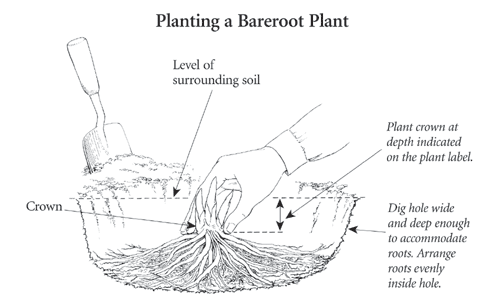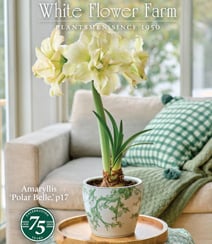Basic planting advice for bulbs, perennials, annuals, shrubs, and vines
Planting is simple if you follow a few basic steps that vary slightly according to the kind of plant and the way it was shipped.
Bulbs. Bulbs are easy to plant. With a trowel or bulb planter, dig a hole to the depth indicated on the plant label. Set the bulb in the hole with the roots down (if you can't find any roots, plant the bulb on its side). Then fill the hole with soil and water thoroughly. Bulbs grown in large, deep containers should be planted at the recommended depth. In small pots, they should be planted at half of the normal depth.
Bareroot perennials. To plant a bareroot perennial, begin by unwrapping the plastic and removing (and discarding) the packing material that surrounds the roots. With a trowel, dig a hole wide enough to accommodate the spread of the roots and deep enough to allow you to set the crown—the point where the leaves of the plant meet the roots—1in below the surface of the soil.

Place the roots in the planting hole and arrange them like the spokes of a wheel or in whatever fashion appears natural (see drawing). Holding the crown of the plant with one hand, push soil into the hole with the other, working soil around the roots to prevent the formation of air pockets. Then firm the soil around the crown, pressing down with both hands. Finally, water thoroughly, even if rain threatens, to settle the soil.
It's not always easy to tell which end of a bareroot plant is up. In their dormant state, some plants, Ferns and Liatris are good examples, may lack obvious roots. Look for buds or the remains of stems and leaves, and plant them facing up. When in doubt, lay the crown on its side; the plant knows to send shoots up and roots down.
Container-grown annuals and perennials. Dormant container-grown perennials are ready to plant as directed in the following paragraph. Container-grown annuals and perennials with leafy new growth are fresh from the protected environment of a greenhouse; they need a gradual introduction to direct sun and stiff breezes before planting. Set plants outdoors in a sheltered, lightly shaded spot, increasing their exposure to sun and wind each day for up to 3 days.
To plant a container-grown annual or perennial, first check the moisture of the potting mix in the container. Water thoroughly if it's dry. Then dig a hole large enough to hold the container. Remove the plant from the pot by grasping the rim, turning the pot upside down, and tapping it against the heel of your hand. Next gently break up the sides of the root ball (the block of potting mix held together by the roots) with your thumbs and pull apart roots that are circling at the bottom. This operation encourages the roots to grow out of the soil mix into the surrounding soil. Set the root ball in the hole so that the top of the ball is level with the surface of the surrounding soil. Then push soil around and just over the top of the root ball, firm the soil, and give the plant a thorough soaking.
Bareroot woody plants. Plant bareroot shrubs, trees, and vines as you would bareroot perennials, with three differences.
- First, before planting, remove (and discard) the packaging and soak the roots in a pail of water for a few hours (no longer).
- Second, take extra care when arranging the roots in the planting hole not to break them; the roots of many woody plants are brittle.
- Third, after planting, surround the main stem with a 1-2ft diameter ring of soil mounded to catch and hold water and channel it down to the roots. (See Planting Roses.)
Container-grown woody plants. Plant container-grown shrubs, trees, and vines that are destined for prepared beds, such as shrub or mixed borders, as you would container-grown annuals and perennials.
Container-grown woody plants that are to be planted in unimproved soil need different treatment. Begin by checking the moisture of the potting mix in the container. Water thoroughly if it's dry. Then dig a hole several times the diameter of the root ball but no deeper than the height of the root ball. Remove the plant from the pot and gently break up the sides of the root ball with your thumbs (you may find it easier to make several vertical cuts with a knife) and set it in the center of the hole. Push soil back into the hole and just over the top of the root ball, firm the soil with your hands or feet, and soak with a hose set to a slow trickle. A ring of soil 1-2ft in diameter mounded around the main stem will catch and hold water and channel it down to the roots.
For most woody plants, there is no benefit to amending the soil before planting. Rhododendrons, Azaleas, and Mountain Laurels are exceptions. They grow better if an acidic soil amendment such as peat moss (shredded pine bark is often recommended in the South) is worked thoroughly into the soil at planting time. Please note: dormant woody plants, whether bareroot or container-grown, vary widely (even between plants of the same variety) in the timing of their return to active growth. If a plant is slow to leaf out, gently scratch the bark near the tip of a branch with your fingernail. If the inside is green, the plant is still alive and is just taking its time. Please be patient.
Aftercare: Feeding, watering, mulching, pest & disease control, overwintering


